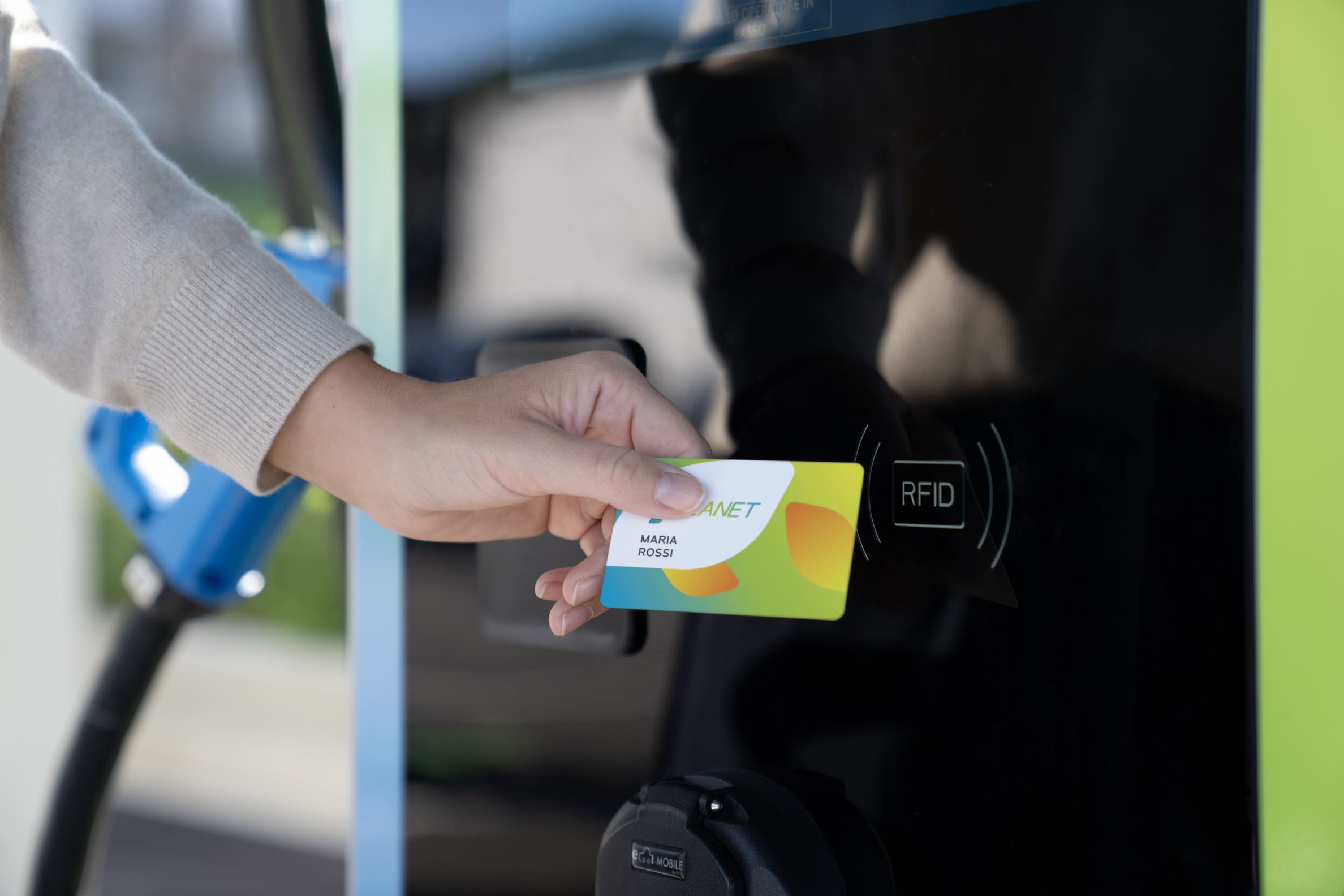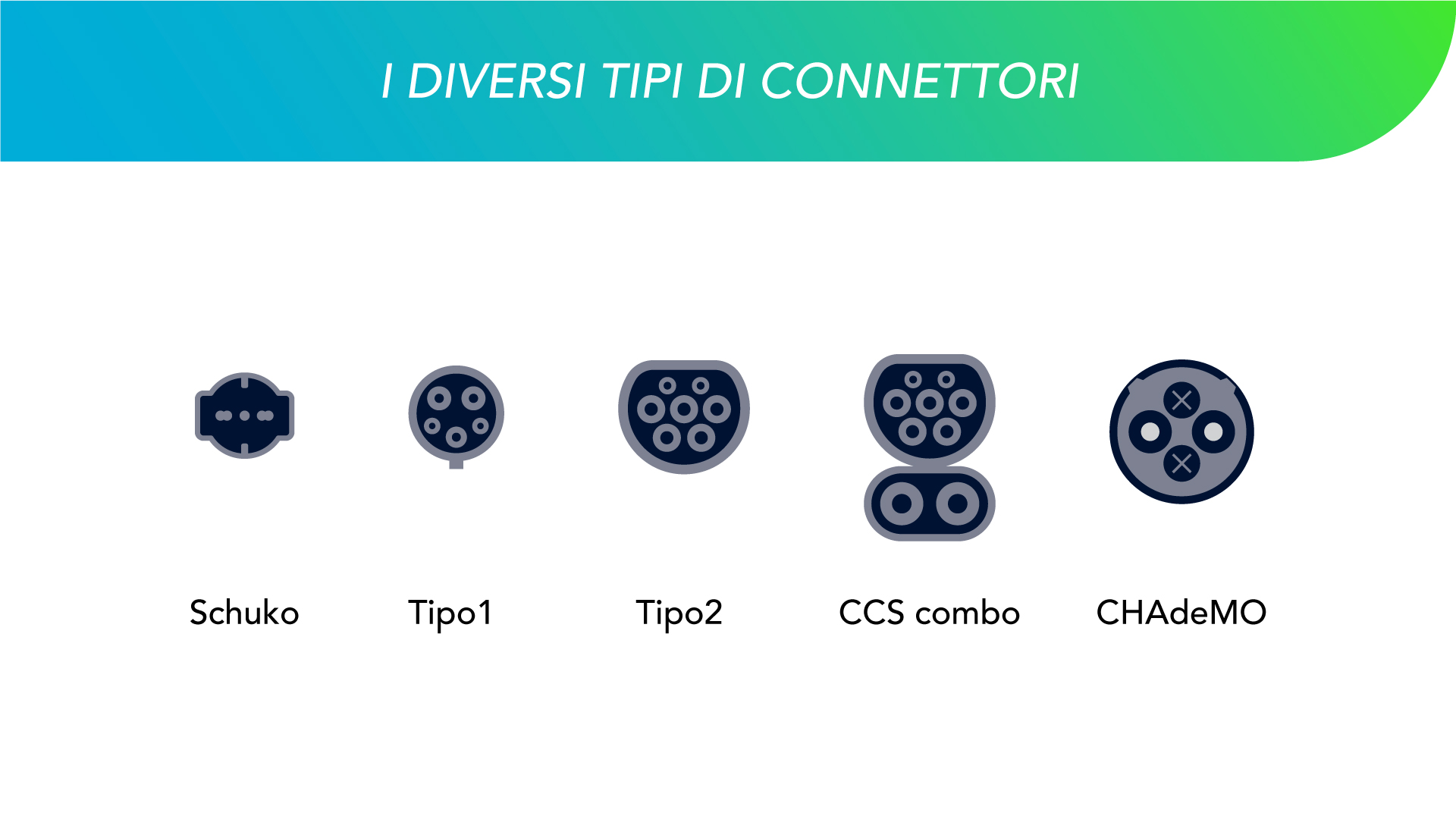
Magazine
Guide to electric vehicle charging stations
With the rise in electric vehicle registrations, the need for reliable and widespread infrastructure is growing accordingly. Electric vehicle (EV) charging stations have become a key reference point for those who choose to drive an electric car, both in the city and along all major traffic routes.
For this reason, it is very important to know how charging stations work, to recognise the different types of systems and connectors and the power levels and charging speeds available.
How electric vehicle charging works
Charging an electric vehicle may seem complicated at first, but in actual fact the process is very simple.
To hook up to an electric charging station, simply plug the power cable into the socket on the vehicle and launch the charging session via app, RFID card or contactless payment system. Once connected, the charging station communicates with the vehicle and regulates the power supply safely, preventing overloads.

How charging stations work
Charging stations can operate in two main ways, depending on the type of current supplied:
- Alternating current (AC): the current supplied is the same as that in the domestic power grid. The vehicle incorporates an onboard charger that converts the energy for the battery.
- Direct current (DC): typical of ultra-fast stations, this allows you to bypass the vehicle’s onboard charger and supply the energy directly to the battery, with much faster charging times.
Many drivers are unsure how to charge an electric vehicle at a charging station on the road: the process is practically the same as charging at home, except that public charging stations are equipped with identification and payment systems, making the process safe and simple.
Different types of charging stations and their technical specifications
Not all charging stations are the same. EV charging stations differ in power, speed and instructions for use. Their construction and installation is regulated by the National Plan for Charging Infrastructure which contains all the guidelines regarding the infrastructure network.
Let’s have a look at the various types of charging stations:
Home EV charging station
Many home owners choose to install an electric vehicle charging station at home. These devices – Wallboxes – are installed in the garage or parking space to allow slow and safe charging. The home EV charging station is ideal for those who make short-to-medium trips each day and can leave the car plugged in for several hours, e.g. overnight. They are not particularly powerful: they usually supply between 3.7 and 7.4 kW AC, but are ideal for everyday use.
Public EV charging station
Public charging stations, on the other hand, are installed in shopping centres, on motorways and in car parks. This type of EV charging station can have much higher power levels than home solutions. They can usually supply up to 22 kW, sometimes even 43 kW in the three-phase versions. In these cases, charging takes a few hours, so it is ideal for those who leave their car parked while at work or while shopping.
Fast charging stations
Fast charging stations using direct current (DC) are often found along non-urban roads and at service stations. These charging stations can supply 50 to 150 kW and can charge 80% of the battery in roughly 30 to 60 minutes, considerably reducing waiting times compared to AC charging stations.
Ultra-fast charging stations
New generation charging stations focus on ultra-fast charging using direct current (DC). These EV charging stations, usually found in service stations, are the most powerful and advanced models, designed for motorway routes or for those who only have time for short breaks. With power levels of up to 400 kW, these charging stations make it possible to top up hundreds of kilometres of autonomy in a matter of minutes, making them indispensable for long journeys.
By consulting the charging station map, you can locate the nearest charging stations so as to be able to charge your electric vehicle as quickly and as efficiently as possible.
Wireless EV charging stations
Last but not least, there is another type of technology that is not yet widespread but totally fascinating: induction, or wireless, charging stations. In this case, there is no need to connect any cables: just park the vehicle on a small pad that transfers energy directly to the battery via electromagnetic induction. At the present time, these charging stations are not very fast, and are suitable, for the most part, for slow or scheduled charging, but they give a clear idea of what the future might bring: wireless charging, simply and naturally. In practical terms, you simply park and forget all about the battery.
The different types of connectors
A key aspect to consider is compatibility between the vehicle and the charging station. Each electric vehicle charging station is equipped with connectors that vary according to international standards.

Here are the various types:
- Schuko
This is the common plug we use daily in our homes for electrical appliances. It can be used to charge vehicles with alternating current either through dedicated charging boxes or directly, in the case of vehicles designed for micromobility. - Type 1
This connector is very rare in Europe and is mainly installed on cars imported from the United States. It often requires an adaptor to connect to local charging stations, but it works perfectly when you have everything you need to hand. - Type 2
This is the most common type for AC charging in Europe and is also known as a Mennekes connector. Almost all electric vehicles sold today are compatible with this connector, and it is used by most public charging stations. Thanks to this connector, the vehicles can receive power levels of up to 22 kW, which means that even a relatively long charge can be completed in a matter of hours. - CCS Combo
This connector is now present on almost all new models, so that the power of fast and ultra-fast charging stations can be employed to the full. It allows high-power DC charging. It is the European standard for fast charging and can be found in most EV charging stations. - CHAdeMO
Used mainly by Japanese car manufacturers, it allows fast DC charging. It is gradually being replaced by the CCS (Combined Charging System) in Europe, but many charging stations still offer both options.
There is also a type of socket called 3A, with alternating current, which is used for charging two- or four-wheel electric mopeds.
Speed and power
The speed of electric vehicle charging depends mainly on the power output of the charging station and the battery capacity of the vehicle. Based on these factors, charging can be classified into different types:
- Slow Charging
This type of charging uses alternating current, at power levels of between 2 and 7.4 kW. This is how a home charging station or an apartment block charging point typically works.
It allows a car to be charged in 6-12 hours, so it is ideal for those who can leave their car parked overnight and need to set off each morning with a full battery. - Quick Charging
This type of charging is faster than slow charging, with power levels of between 22 and 50 kW, and only takes a few hours. This type of EV charging station is often found in public urban areas and can fully charge a vehicle during an extended stop. Here charging is faster: in a few hours a good percentage of autonomy can be regained, ideal for stops during shopping trips or outside the workplace. - Fast Charging
Fast DC charging stations are a great advantage. With power levels from 50 kW to 150 kW, a sizeable percentage of the battery can be charged in 30-60 minutes. They are ideal for short stops on motorways or country roads, when time is precious. - Ultrafast Charging
These decidedly advanced charging stations offer power levels of up to 400 kW. With an ultra-fast electric vehicle charging station it is possible to charge 80% of the battery in less than half an hour, depending on the vehicle type. These stations are designed for long, fast routes.
The development of electric vehicle charging stations is crucial for supporting the transition to sustainable mobility, and the presence of EV charging stations along motorways is becoming an increasingly common sight, removing one of the main obstacles perceived for those considering the purchase of an electric car.
Recognising the different types of charging stations, understanding how they work and knowing how to charge an electric car at a charging station on the road is essential in order to be able to make the most of this new driving experience.
Whether it is an EV charging station in your own garage or on the motorway, the infrastructure is constantly evolving.
Read also
Information is energy for the mind. Explore articles, offers, and news dedicated to the world of electric mobility and stay up-to-date on everything IPlanet.

Download our App
Did you know? Keep everything under control with IPlanet. Find easily your nearest stations, start charging, monitor your consumption in real time and manage your payments. Electric mobility has never been so easy.
Find out moreElectric mobility, everywhere.
IPlanet offers you a complete ecosystem of online and offline services to simplify travel. EV charging points, traditional fuel pumps and refreshment areas: every last detail has been designed to guarantee you a complete experience. Control everything at a click on our App and website!
Find our moreIplanet. The ultrafast solution to your charging needs
Find your nearest charging point
Use our ultrafast charging points and dedicate more time to the things you love.
Pay directly from the App
Start charging from your smartphone to save time and money
Benefits and deals
Follow our channels to discover more promotions just for you.
Our Energy
is 100% Renewable
IPlanet certifies the origin of all the energy supplied by its ultra-fast charging stations. In 2024, we received a Cancellation Statement from the Energy Services Manager (GSE), confirming the cancellation of 260 Guarantees of Origin, equivalent to 260 MWh of renewable energy used.
